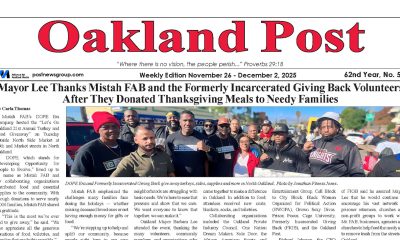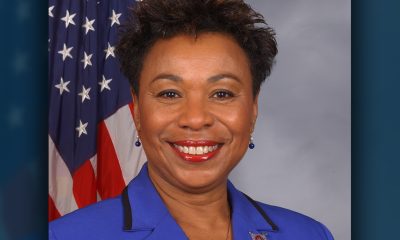Business
Whole Foods: New Chain to be Named for ‘365’ Store Brand

This image provided by Whole Foods shows the logo for 365 by Whole Foods Market, a new chain of smaller stores with lower prices, named after its “365” house brand. Co-CEO Walter Robb says the private-label products will anchor the store, but that it will also have a selection of curated products, including national brand name products. (Whole Foods via AP)
CANDICE CHOI, AP Food Industry Writer
NEW YORK (AP) — Whole Foods says it will name its new chain of smaller stores with lower prices after its “365 Everyday Value” house brand.
Co-CEO Walter Robb tells The Associated Press that the chain will be named “365 by Whole Foods Market,” a nod to the brand already sold by the grocery chain.
He said that while 365 products will anchor the stores, the chain will also have other items, including national brands.
Since announcing plans for the chain in May, recent trademark filings by Whole Foods Markets Inc. had prompted a guessing game that the stores might bear names like Clever Egg, DailyShop, Greenlife, Small Batch or Swiftgoods.
“Those were all decoys,” Robb said in an interview, before quickly adding that his claim could also be a decoy to divert people about other plans.
The new chain, which is slated to begin opening next year, comes as Whole Foods seeks to differentiate itself amid intensifying competition. The company, which has more than 400 Whole Foods stores, has seen its sales growth slow as organic and natural products have become more widely available at mainstream supermarket chains and big-box retailers.
The new chain may also be inspired by the success of companies such as Trader Joe’s and Sprouts, which also focus on value and store-brand products, said Jon Springer, retail editor for the trade publication Supermarket News.
“They’ve identified millennial shoppers, younger shoppers who are very particular about what they eat, but also tough about what they can spend on food,” he said.
Executives in the supermarket and retail industry are also trying to adapt to the changing ways people are shopping. Wal-Mart Stores Inc., for instance, has been opening “Neighborhood Market” stores that are smaller than its supercenters aimed at shoppers who want to get in and out quickly.
A similar philosophy seems to be behind the plan by Whole Foods. In its initial announcement, Whole Foods had said that the new chain would be “geared toward millennials.” But Robb said that while 365 is inspired by younger generations, it’s intended to appeal to anyone who wants a quick, convenient way to shop.
Jeff Turnas, a Whole Foods veteran who was named president of the 365 chain, said he envisions people stopping in at 365 stores during the week when they want to get in and out of stores, with the regular Whole Foods stores being destinations for bigger shopping trips.
Turnas, who previously headed the U.K. business for Whole Foods, also noted that a small Whole Foods location in London has an open-kitchen feel in its prepared food section. Turnas said something similar might pop up in the 365 stores as well.
Whole Foods says it plans to open between five and 10 of the 365 stores around the country next year, and that it sees potential for the chain to eventually have as big a footprint as its namesake chain. The company, based in Austin, Texas, has provided few other concrete details about its plans for the chain.
In an earnings conference call in May, co-CEO John Mackey had described it as a “streamlined, hip, cool technology oriented store, unlike any store anybody has ever seen before.”
When asked this week what 365 stores will look like, Robb remained similarly vague. He asked that people close their eyes and “stay with me on the words and flow” of his description. He then proceeded to ask people to envision a place “that’s fresh, that’s clean” with a smaller, more neighborhood feel, a “streamlined” selection and “technology woven in,” although he declined to say what type of technology that might entail.
But despite the bigger focus on value, Robb stressed the products in the 365 stores will have the same quality standards as “the mothership.”
“It’s not going to be a dumbed-down thing,” he said.
___
Follow Candice Choi at www.twitter.com/candicechoi
Copyright 2015 The Associated Press. All rights reserved. This material may not be published, broadcast, rewritten or redistributed.
Activism
Ann Lowe: The Quiet Genius of American Couture
Lowe was born in Clayton, Alabama, into a family of gifted seamstresses. Her mother and grandmother were well-known dressmakers who created exquisite gowns for women in the area. By the time Lowe was a young girl, she was already showing extraordinary talent — cutting, sewing, and decorating fabric with a skill that far exceeded her age. When her mother died unexpectedly, Lowe – only 16 years old then – took over her mother’s sewing business, completing all the orders herself.

By Tamara Shiloh
Ann Cole Lowe, born Dec.14, 1898, was a pioneering American fashion designer whose extraordinary talent shaped some of the most widely recognized and celebrated gowns in U.S. history.
Although she designed dresses for society’s wealthiest families and created masterpieces worn at historic events, Lowe spent much of her life in the shadows — uncredited, underpaid, yet unmatched in skill. Today, she is celebrated as one of the first nationally recognized African American fashion designers and a true visionary in American couture.
Lowe was born in Clayton, Alabama, into a family of gifted seamstresses. Her mother and grandmother were well-known dressmakers who created exquisite gowns for women in the area. By the time Lowe was a young girl, she was already showing extraordinary talent — cutting, sewing, and decorating fabric with a skill that far exceeded her age. When her mother died unexpectedly, Lowe – only 16 years old then – took over her mother’s sewing business, completing all the orders herself. This early responsibility would prepare her for a lifetime of professional excellence.
In 1917, Lowe moved to New York City to study at the S.T. Taylor Design School. Although she was segregated from White students and forced to work separately, she, of course, excelled, graduating earlier than expected. Her instructors quickly recognized that her abilities were far above the typical student, especially her skill in hand-sewing, applique, and intricate floral embellishment – techniques that would become her signature.
Throughout the 1920s and 1930s, she designed gowns for high-society women in Florida and New York, operating boutiques and working for prestigious department stores. Her reputation for craftsmanship, originality, and elegance grew increasingly. She was known for creating gowns that moved beautifully, featured delicate hand-made flowers, and looked sculpted rather than sewn. Many wealthy clients specifically requested “an Ann Lowe gown” for weddings, balls, and galas.
Her most famous creation came in 1953: the wedding gown worn by Jacqueline Bouvier when she married Massachusetts Sen. John F. Kennedy. The dress – crafted from ivory silk taffeta with dozens of tiny, pleated rosettes – became one of the most photographed bridal gowns in American history. Despite this achievement, Lowe received no public credit at the time. When a flood destroyed her completed gowns 10 days before the wedding, she and her seamstresses worked day and night to remake everything – at her own expense. Her dedication and perfectionism never wavered.
She eventually opened “Ann Lowe Originals,” her own salon on New York’s Madison Avenue. She served clients such as the Rockefellers, DuPonts, Vanderbilts, and actresses like Olivia de Havilland. Yet even with her wealthy clientele, she struggled financially, often undercharging because she wanted every dress to be perfect, even if it meant losing money.
Lowe’s contributions were finally recognized later in life. Today, her exquisite gowns are preserved in museums, including the Smithsonian National Museum of African American History and Culture and the Metropolitan Museum of Art.
In the last five years of her life, Lowe lived with her daughter Ruth in Queens, N.Y. She died at her daughter’s home on Feb. 25, 1981, at the age of 82, after an extended illness.
Activism
BRIDGE Housing President and CEO Ken Lombard Scores Top Honors for Affordable Housing Leadership
The Development Company of the Year honor represents a milestone for BRIDGE Housing, which received the Gold award—its top designation—in a category that included both affordable and market-rate developers. The recognition caps what has been one of the strongest growth periods in the organization’s 42-year history.

By the Oakland Post Staff
San Francisco-based BRIDGE Housing and its president and CEO, Ken Lombard, have been named among the nation’s housing industry standouts, earning two of the top prizes at the 2025 Multi-Housing News Excellence Awards.
BRIDGE Housing was named Development Company of the Year, while Lombard received Executive of the Year, recognition that places the nonprofit affordable housing provider alongside leading national developers of both affordable and market-rate housing.
The awards were announced in New York for the accomplishments achieved during 2024.
Multi-Housing News is one of the industry’s most respected publications. Award winners are selected by a panel of housing professionals, including multifamily developers, architects, and owners.
“BRIDGE Housing is deeply honored to be recognized by Multi-Housing News and our industry peers,” Lombard said. “These awards are a testament to the high-impact, mission-driven work by BRIDGE’s exceptional team to deliver quality affordable housing and support services that empower residents to improve their lives.”
The Development Company of the Year honor represents a milestone for BRIDGE Housing, which received the Gold award—its top designation—in a category that included both affordable and market-rate developers. The recognition caps what has been one of the strongest growth periods in the organization’s 42-year history.
In 2024, BRIDGE significantly expanded its footprint across California, Oregon, and Washington. That momentum continued into 2025, with portfolio growth of 9%, including the addition of nine new communities and 1,187 new or acquired affordable housing units. The nonprofit also added three new projects to its development pipeline as it nears a portfolio of 16,000 units.
The growth reflects a broader strategy aimed at accelerating both acquisitions and ground-up development, supported by partnerships with major financial institutions and innovative capital markets strategies. BRIDGE has also emphasized high-quality design and deep community engagement as central elements of its approach.
BRIDGE became the first affordable housing developer to issue tax-exempt construction bonds for one of the largest affordable housing projects in Portland, Ore., leveraging its strong credit rating.
Earlier this year, the nonprofit launched the BRIDGE Housing Impact Fund, with a goal of investing $1 billion to preserve and create affordable housing. It also closed on $175 million in taxable general-obligation bonds after increasing the offering in response to strong investor demand.
The company’s performance also underscores the role of Lombard, who has led BRIDGE since 2021 and was honored individually for his leadership.
Under Lombard’s tenure, BRIDGE has built a new leadership team with experience drawn from both the nonprofit and private sectors, with a particular focus on what the organization describes as efforts to “break the status quo,” especially in affordable housing finance. Those initiatives have helped reduce capital and construction costs, strengthen relationships with institutional investors, and expand resident support services.
Today, BRIDGE Housing serves more than 33,000 residents across 139 communities on the West Coast.
“Ken has dedicated his career to innovative real estate solutions that improve the quality of life in underserved neighborhoods,” said Kenneth Novack, chair of BRIDGE Housing’s board of directors. “His visionary leadership and the work of our incredible team have positioned BRIDGE for long-term growth that will extend our impact throughout the West Coast.”
Founded in 1983, BRIDGE Housing has helped create more than 23,000 affordable homes with a total development cost of $6 billion.
Activism
Mayor Lee, City Leaders Announce $334 Million Bond Sale for Affordable Housing, Roads, Park Renovations, Libraries and Senior Centers
Saying “Oakland is on the move,” Mayor Barbara Lee announces results of Measure U bond sale, Dec. 9, at Oakland City Hall with city councilmembers and city staff among those present. Photo courtesy of the City of Oakland.

By Post Staff
The City of Oakland announced this week that it is successfully moving forward on the sale of $334 million of General Obligation bonds, a milestone that will provide the city with capital funding for city departments to deliver paved roads, restored public facilities, and investments in affordable housing.
“Oakland is on the move and building momentum with this bond sale,” said Oakland Mayor Barbara Lee. “We are reviving access to funding for paving our streets, restoring public facilities we all use and depend upon, and investing in affordable housing for our community, all while maintaining transparency and fiscal discipline.”
“These bonds represent our city’s continued commitment to sound financial management and responsible investment in Oakland’s future,” said Lee.
“Together, we are strengthening our foundation for generations to come,” she said. “I’m grateful to our partners in the City Council for their leadership and support, and to City Administrator Jestin Johnson for driving this process and ensuring we brought it home.”
According to the city, $285 million of the bonds will support new projects and $49 million of the bonds will refund existing bonds for debt service savings.
Oakland issued the Measure U bonds on Dec. 4 after two years of delays over concerns about the city’s financial outlook. They all sold in less than a week.
The new money bonds will pay for affordable housing, roadway safety and infrastructure improvements, and renovations to parks, libraries, senior centers, and other public facilities under the city’s Measure U Authorization.
Citywide paving and streetscape projects will create safer streets for Oaklanders. Additionally, critical facilities like the East Oakland Senior Center and San Antonio Park will receive much-needed renovations, according to the city.
Some of the projects:
- $50.5 million – Citywide Street Resurfacing
- $13 million – Complete Streets Capital Program
- $9.5 million – Curb Ramps Program
- $30 million – Acquisition & Preservation of Existing Affordable Housing
- $33 million – District 3: Mandela Transit-Oriented Development
- $28 million – District 6: Liberation Park Development
- $3 million – District 5: Brookdale Recreation Center Capital Project
- $1.5 million – District 1: Oakland Tool Lending Library (Temescal Branch Library)
- $10 million – District 3: Oakland Ice Center
“I recognize that many naysayers said we couldn’t do it,” said Johnson. “Well, you know what? We’re here now. And we’re going to be here next year and the year after. The fact is we’re getting our fiscal house in order. We said we were going to do it — and we’re doing it.”
Investors placed $638 million in orders for the $334 million of bonds offered by the City. There was broad investor demand with 26 separate investment firms placing orders. The oversubscription ultimately allowed the city to lower the final interest rates offered to investors and reduce the city’s borrowing cost.
“The oversubscription ultimately allowed the City to lower the final interest rates offered to investors and reduce the City’s borrowing cost,” said Sean Maher, the city’s communications director.
“The Oakland City Council worked closely with the administration to both advance the bond issuance process and ensure that the community had a clear understanding of the City’s timeline and approach,” said Councilmember at-Large Rowena Brown.
“In September, the City Council took unanimous action to authorize the Administration to move forward with the bond sale because these funds are essential to delivering the very improvements our communities have long asked for – safer streets, restored public facilities, and expanded affordable housing,” she said.
Continuing, Brown said, “I want to extend my sincere thanks to City Administrator Jestin Johnson, Finance Director Bradley Johnson, and Mayor Barbara Lee for their leadership, diligence, and steady guidance throughout the City’s bond sale efforts.
“Navigating complex market conditions while keeping Oakland’s long-term infrastructure needs front and center is no small task, and this moment reflects tremendous professionalism and persistence,” she said.
Moody’s gave the city an AA2 rating on the bonds, its third-highest rating, which it gives to high-quality investment-grade securities.
There was both a tax-exempt portion and a taxable portion for the bond offering, reflecting the various uses of the bond proceeds, according to a statement released by the city.
The $143.5 million of tax-exempt bonds have a 30-year final maturity and received an all-in borrowing cost of 3.99%. The $191 million of taxable bonds have a 24-year final maturity and received an all-in borrowing cost of 5.55%.
The $49 million in tax-exempt bonds that refinance existing obligations of the City resulted in $5.6 million of debt service savings for taxpayers through 2039, or $4.7 million on a present value basis.
Mayor Lee said that, based on her experience serving on the House Financial Services Committee of the U.S. Congress for more than 10 years, city staff has done an exemplary job.
“I have witnessed many cities go to the bond market throughout the years,” she said. “I can tell you with certainty that Oakland’s team is remarkable, and our residents should be proud of their reputation, their competence, and their deep knowledge of this very sophisticated market.”
Looking ahead to the final sale of the bonds, according to the city press statement, pricing marks the point at which the City and investors locked in the final dollar amounts, interest rates, and other key terms of the bond sale. This stage is commonly referred to as the sale date. At pricing, no funds are exchanged. The actual delivery of bonds and receipt of monies occurs at closing, which is scheduled within the next two weeks.
Capital projects receiving this funding will proceed on individual timelines based on their individual conditions and needs. At the time of closing, funding will be immediately available to those projects.
-

 Activism4 weeks ago
Activism4 weeks agoIN MEMORIAM: William ‘Bill’ Patterson, 94
-

 Activism4 weeks ago
Activism4 weeks agoOakland Post: Week of November 19 – 25, 2025
-

 #NNPA BlackPress3 weeks ago
#NNPA BlackPress3 weeks agoLIHEAP Funds Released After Weeks of Delay as States and the District Rush to Protect Households from the Cold
-

 #NNPA BlackPress4 weeks ago
#NNPA BlackPress4 weeks agoBeyoncé and Jay-Z make rare public appearance with Lewis Hamilton at Las Vegas Grand Prix
-

 Alameda County2 weeks ago
Alameda County2 weeks agoSeth Curry Makes Impressive Debut with the Golden State Warriors
-

 Activism3 weeks ago
Activism3 weeks agoOakland Post: Week of November 26 – December 2, 2025
-

 #NNPA BlackPress3 weeks ago
#NNPA BlackPress3 weeks agoSeven Steps to Help Your Child Build Meaningful Connections
-

 #NNPA BlackPress3 weeks ago
#NNPA BlackPress3 weeks agoSeven Steps to Help Your Child Build Meaningful Connections




















































